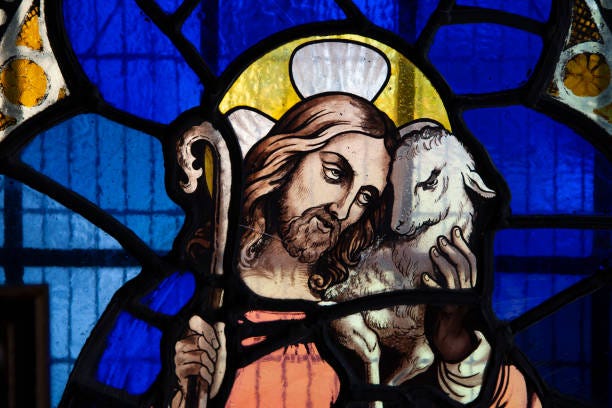Is eating lamb at Easter "the right thing to do"? [WFJ #9]
One Frome butcher-farmer says the tradition is more symbolic than sustainable
About three quarters of the British population will soon be planning their Easter celebrations. For many, that means acquiring a lamb joint for their Sunday roast. But however well ingrained it is, this custom might not be such a good idea.
“Basically, Easter is the wrong time to be eating lamb,” says Owen Singer, who owns Penleigh butchers on Stony Street. “Inherently, lambs are only starting to pop out in early March. If you think you need to get lamb from the end of March, then they need to be born in January, when there's not much grass and the weather's shit. So is that the right thing to do? All because, by tradition, we need to eat lamb on Easter Sunday?”
It’s a relatively recently-found tradition, at that. England was a powerhouse of the European wool trade from the middle-ages (Frome itself became famous for its “manufacture of broad and woolen cloths”)1 which made eating sheep almost unthinkable, especially when so young as a lamb. Doing so would waste the profitable fleeces it would otherwise produce throughout its life, so mutton – that is, meat from an older sheep – was much preferred.2
Post industrialisation, the tables turned, and gradually wool became seen as the byproduct of sheep cultivated for their meat. As the UK population rocketed in the Victorian era, so too did the need to feed all those new mouths, so for sheep farmers, the pressure was on to transition from wool to meat production.
As wool devalued, it was pointless, and expensive, for a farmer to keep an unproductive sheep in their flock. Like with veal, it became preferable to send young male sheep surplus to requirements to the abattoir as soon as realistic. Not like veal however, the animal has strong, convenient tie-ins with religion. Liz Dudley, the reverend at Christ Church and St Mary’s in Frome, tells me the Old Testament is riddled with references to lambs, sheep, and shepherds. But it’s The Plagues of Egypt in the Book of Exodus which is the most convincing.
“The last plague that God sends, is that the angel of death will pass over the land, and will kill the firstborn of everything,” Liz says. “And the instruction was that they would take the blood of a lamb and mark their [carpenter’s] tools with their blood, and they should roast – not boil – the lamb and eat, ready to flee. From that story we get the tradition of Passover, and our date for Easter is linked to Passover.”
Even so, lamb as a symbol of sacrifice reaches its peak in John’s gospel, and it is perhaps here where lamb is most closely linked to the modern religious foundations of Easter, in death and resurrection. “Here,” says Liz, “in the way that they sacrificed lamb – which took them so far in the relationship with God – Jesus comes along and moves it up a level by being the sacrifice that enables us to find a way back to God.”
To have grass-fed lamb at Eastertime means it’s likely to come from climates opposing ours, like that of New Zealand. Thousands of miles can separate farm from plate, but does Liz think tradition is strong enough – among Christians or otherwise – to carry on regardless? “Yeah. It's like having turkey at Christmas. Even if you don't understand where it's come from.”
The other possibility is your Easter lamb’s from a breed not limited by the seasons. Or, as Owen puts it, is “up for it all year round,” which was the case with the Dorset breed he reared for the shop until a couple of years ago. “But you have to lamb inside, and make sure there's plenty of dry food like hay as there's no energy in the grass.”
A stocky breed with a thick coat, Dorsets might be built for the colder months. “But it's not great,” says Owen. “Keeping them inside you think would be the nice thing to do, but they get too hot and sweaty, and there’s an increase in mastitis3 however much straw you put down. Whatever you have to do for them isn't what I'd call optimal. What I would call optimal is having lambs pop out in March on a beautiful spring day so it can do its own thing in the field.”
Lambs need at least six months to mature before they’re ready for slaughter, but even by that point they haven’t put down much weight or fat. Perhaps, then, the issue is less ‘why are we eating lamb at Easter’, and more ‘why are we eating lamb at all.’
So, an alternative: At 12 months old, but under two years, lamb becomes hogget, which is cheaper to eat and more ethical to rear. Plus, as Owen points out, it’s a superior meat anyway. “People get excited about spring lamb, as they think it has the best flavour. I don't think it does. It hasn't been around long enough to gain anything.”
Owen sells lamb at Easter whenever people specifically ask for it, but they have to cover the higher cost. Otherwise, he sells hogget for as long as it’s available. The difference, he says, “is people aren’t paying a premium for something that isn’t as good.”
This article was adapted from one I’m publishing in Riverford’s Wicked Leeks, April 2022
Further reading:
https://frome-heritage-museum.org/wool-trade
https://localhistories.org/a-history-of-frome/
These days, mutton has the unfortunate stigma of being tough and sinewy. While it’s true you don’t want a too old a sheep, mutton has a ton of flavour. And mutton mince is great for kofte. As Owen says, “there’s mutton, then there’s mutton.”
Inflammation from an infection of the udder







